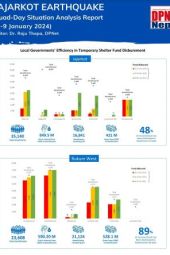Jajarkot Earthquake : Quad-Day Situation Report (6-9 Jan 2024)
Summary
This report highlights the ongoing challenges and responses following the devastating earthquake. More than two months later, 39,156 families remain in makeshift tarpaulin tents, struggling with the harsh winter weather and various reasons including bureaucratic hurdles that have impeded the construction of temporary shelters. In Jajarkot, out of 35,140 identified beneficiaries, only 16,841 have received the first installment for housing construction, totaling Rs. 421.02 million. This has resulted in the construction of only 9,169 temporary shelters, representing just 26% of the need. The fund disbursement varies significantly across municipalities, with some areas like Shiwalaya Rural Municipality achieving an 86.8% disbursement rate, while others like Nalgad Municipality and Chhedagad Municipality are far behind, with only 14% and 10% of their beneficiaries’ receiving grants, respectively.
Rukum West faces similar challenges, although fund disbursement has been more proactive. Despite this, the construction of temporary shelters is lagging, with 10,423 completed and 7,087 under construction out of a total of 23,608 beneficiaries’ just 45% of total requirement. The total disbursement percentage for Rukum West stands at 89.5%, yet discrepancies in areas like Banphikot RM, which shows no recorded disbursement, highlight the need for equitable and efficient distribution.
The slow pace of fund distribution is attributed to several factors, including limited banking services, documentation errors, absenteeism of house owners residing outside Nepal, and the requirement for new bank accounts ignoring social security allowance bank account. The increase in applicants for reconstruction grants further complicates the situation. Suspicions of claim inaccuracies and disputes over eligibility criteria, such as considering multiple families residing in the same house as one unit for grant purposes, add to the delay.
Among these struggles, the provincial government has initiated a comprehensive food security response plan to address the agricultural crisis caused by the earthquake. This plan includes various support programs for livestock rehabilitation, buffalo and goat promotion, agricultural infrastructure development, and support for fruit cultivation, vegetable production, and beekeeping. These initiatives aim to revive the agricultural sector and alleviate the suffering of affected families. However, the Karnali Province faces policy challenges in budget implementation, particularly in the ministry of physical infrastructure and urban development. The earthquake has hindered progress, causing delays in contract finalizations for infrastructure projects.
Adding to the woes, healthcare services in the affected regions are in crisis. Basic medicines are scarce, and patients have stopped visiting healthcare facilities. The lack of commitment from officials in ensuring citizens' fundamental right to health services exacerbates the situation in some municipalities. Vulnerable groups like senior citizens, pregnant women, and children are particularly affected, with the cold weather causing illnesses such as pneumonia and asthma.
Categories:
DPNet Publication
Sub-Categories:
Situation Analysis Report
Published Year:
2024
